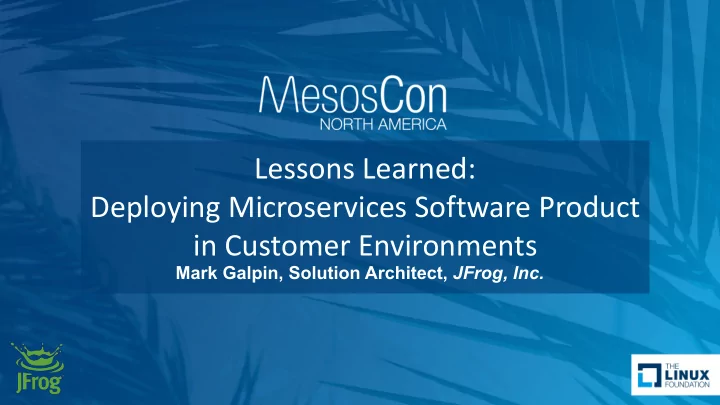

Lessons Learned: Deploying Microservices Software Product in Customer Environments Mark Galpin, Solution Architect, JFrog, Inc.
Who’s speaking? Mark Galpin Solution Architect @jfrog magalpin
Microservices are Cool
But what about installation
A word on the difference between SaaS and On Prem
A tale of three products A legacy (10 years now!) monolithic web application architecture written in Java deployed on premises at thousands of customers world-wide A java-based microservices architecture application designed for the cloud, operating for 5 years, transitioning in 2018 to be offered on premises. Hosts jcenter and homebrew, easily scales to billions of downloads a month A greenfield project in 2016/2017, designed as an on-premises microservices architecture from the start.
So what are we going to talk about? • Discussion of the artifactory experience, what did we learn migrating a legacy monolith to cloud-native? – Major version upgrade was required to modify architecture • Discussion of the xray experience. Microservices design on prem: How did it go? • Based on this what are we taking forward into the next one?
A place to start: Artifactory HA
A first step: VM orchestration • Lesson: Separation between the application layer, and the configuration layer. • Example: health check (/api/system/ping), – What is it: confirms artifactory web service, and connection to DB and filestore. Best way to test – Problem: It required an authenticated user – Solution: Make an anonymous version of this available
VM orchestration • The importance of startup scripts • Issue: Health check starts before application starts • Solutions? – Complex script to try to prevent health check from initating until successful start – Just wait long enough
A first step: Early containerization • Install the artifactory RPM in a container and we’re done, right? • What about HA? – Different directory structure! – Take default image and “customize” – NFS requirement?
The first Mesos implementation • First container based self-healing orchestration of Artifactory – Thank you mesos team for much assistance! – Able to leverage existing mesos capabilities for most things – Able to leverage mesos-based DB services • Issues: – User MUST supply an external NFS mount – License management required an extensive hack
Enter Artifactory 5! • Artifactory 5 objective was to take lessons learned from previous cloud-native work • First cloud-native ready version of artifactory. • Major changes: – Config for HA no longer requires shared storage – Creates mechanism for node cross-talk to share config and cached artifacts – No more NFS! – License management for clusters shifted to the application layer
Where we are today? DRAFT ONLY • Cloud-native deployments of artifactory for Mesos, Kubernetes, Docker Swarm • Broke the first microservice out of the monolith into a second web-application service
So what about xray? Back in time.
Lesson 1: Don’t overestimate the customer • We released Xray with a cool docker-in- docker install script and as a set of docker containers. • First request from customers: “Do you have an RPM install of that?”
Lesson 2: Start like you mean to go on • System was architected for enterprise/HA/ etc. • For the 1.0 release, we built/test it only with the default architecture of all containers created on one server • It took most of a year to find all the issues this caused for us to enable HA and horizontal scalability • DevOps!
Lesson 3: Flexibility! • Nearly all requests made have been to give customers more flexibility on install – Ability to specify custom paths – Bring-your-own infrastructure – Source of docker containers
Lesson 4: What about startup scripts? • Startup order: – Microservices are stateless – But they do have dependencies in order to function – Xray startup script explicitly checks dependencies and introduces a startup order – Makes it easier for a customer less familiar with microservices architectures to understand startup process.
Moving forward: Bintray on Premises & JFrog Platform
What does platform look like? ~5 9 1 ~2 ~25
What are we doing with this one? • Simple is better – Consolidate infrastructure services across products – Use small services for scalability & flexibility, but try to keep the total number down for on-premises • Start with the enterprise architecture deployment – If you don’t honor scalability/flexibility at the beginning its harder later • Start with a container-orchestration implementation. Understand we can’t end there.
Most Important Takeaway • DevOps! – Developers and Packaging teams need to be working on deployment/packaging problems from the beginning!
Thank You! • Q&A • By the way, we’re hiring!
Recommend
More recommend